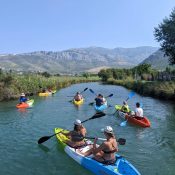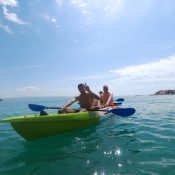Downwind

Downwind
Downwind – The King of Standup Paddle Techniques

downwind gliding
Origin
Let’s talk about one branch of Stand up Paddleboarding that is quite new. Downwind can bring a lot of joy and excitement in an adventurer life. One thing for sure is that as a discipline is getting to be a strong competitor to long living surfing discipline. This discipline uses a bit wider specter of weather conditions that are required for one to start downwinding. So you don’t need waves. Well, you need, but not the ocean-surfing like. What you do need is a proper wind and the wind will accumulate those constantly driven longitudinal waves. Basically, downwind is alike with surfing. When one downwinds, he is getting pushed by the wind. His journey tend to be much longer and straightforward unlike surfing a single wave. It originated from a standard paddleboarding. A bond between racing in the ocean channels and human nature to use any of the natural sources in order to improve his efficiency, speed as such.
Coastline of Split
You see, most of the coastline of Split, where our Sup Center is situated, has been gifted with rocky seabed. Not much natural areas covered with sand and low terrain underwater surfaces where a surfing ocean-like wave could develop. As we are located on a sandy area, one of a 2 spots in Split where you can find any, still, a big wave is lacking specific conditions to generate. Our sandy area, when distanting from shore, quickly becomes rough bottom with variety of depths. That kind of beach does not give a minor chance for a big wave to develop. It happens, though, that that kind of wave my accumulate within 10 meters from shore. Well, try to surf that! So, with that said, surfing in our area definitely is not a thing. Furthermore, every spot in a world has some advantage and some disadvantage what makes that place special in terms of popular activities, in this case, water ones. What can be and has a fairly good chance to become a thing is downwind.
Winds in Split
When you say wind in our area, you can easily start talking about it. It is a story starter and our locals are all familiar with the winds. Firstly, vast majority has had some experiences with the boats and we all know something about the winds and secondly, we live in 4 seasonal area where we could meet up many with varieties of weather. I would be ashamed by some elder local who don’t recognize a certain wind blowing :). Most of our elder locals has some intriguing story to tell, mostly with the boat trips with the some bad weather included.
Where to begin

typical downwind board
The board should look like:
- longer than 11 feet
- planning hull
- pointy nose, narrow board
- cut-off tail
So, when and how do we downwind with the paddle board? First of all, downwind boards are long and narrow. Most importantly, they have some kind of rocker. Those are the planing hull boards. What they do is allowing water to go underneath the board while at the same time lifting the nose of the board. The wave can easily go underneath and prevent your front nose from sinking underneath. Longer boards are desirable with cut-off tail. Usually made up of carbon or wood, but nowadays they can be made out of epoxy and layered up with carbon, usually where the standing area is. The paddleboarding industry and material use is improving every single day.
Those beautiful shaped boards do not come cheap. They can cost up to 3-4 times more from a standard all-round stand up paddle board. That can easily be a defeating parameter for not even purchasing, but rather renting one. In this area, it is a struggle to even find any one of those boards which can be used for a proper downwind. The scene here has not gone up to there. Proper step would be stop by into the surf/stand up paddle shop and taking one for a demo ride. Yes, easier said that done, but if you have any opportunity to take any proper board for a demo ride, do that couple of times prior to your final purchase. Next step should be standing in the middle of the sea pushing first cats into the water. Let us jump to what this sport can offer.
Safety belongings

proper equipment
First thing first, safety. Do not forget these:
- a security leash
- waterproof bag
- charged phone in special waterproof case
- some signaling equipment (flame tube, bell, horn etc..)
- life vest, wet-suit
- food and water
Downwind can be dangerous, especially if you don’t have much experience. Being on open water with wind and waves may cause a lot of trouble and end the joy of sport if you end up in the water alone. Security leash is a must, whenever you loose your board it always comes back, denying any risk of being taken away by the wind and loosing your board. All other necessary stuff should be put in a nicely closed waterproof bag. The best place to store your bag is on your back, rather than using bungee cords as many types of the boards today have. Another reason is that your bag could be easily thrown away by incoming wave and you will find yourself going back to pick it up which can lead to loosing your balance and falling off the board. Wet-suits come up cheap and if the water is cold, purchase one. Put the life vest on too, why not?
How to do it?

how to downwind
If you are good in balancing yourself on a stand up paddle board, it would be much easier for you to handle the chop. If you are comfortable with standing on the board with no much struggle to keep the balance even on a windy day, then you can start your journey. It is big advantage in taking your first downwind steps. But, for most of us, mastering the chop and even taking a glide takes a bit of practice. Sure, like anything. For first time, just consider to take a wind that blows at constant rate. Over here, we have a wind from the south. When blowing for a couple of days, it takes its time to accumulate itself up to a peak until it changes its direction. First day starts kind of slowly and that is a day you want to be in-game. On that kind of water, one should not be able to really glide the waves, but can get lucky and get one at the end.
Taking the first glide
For you it is important to grab directions of the waves properly, facing back to the wind and to do strokes when needed most. When is that? – whenever you feel that a wave has lifted you up, do powerful strokes to maintain that momentum and to keep you gliding on that wave. If your nose is about to dig, that means you have to take step back on the board to keep that nose up. Otherwise, you will dig down and fall off in matter of a second.
You should be practicing movement on the board. Your walk should be like taking step back in your living room. Connecting one foot with another, should close the final gap and there you are standing on a tail completely. That is a success. But, for maintaining that glide as log as you will be needing stronger wind and greater waves. Taking into a next day, your experience should be complete. Giving you a chance to maximize your speed, agility and training your ability to do it in a best possible way.
Below, I will share a couple of links how it should look like when you master your skills at downwind, the king of stand up paddleboarding discipline.
All Categories
Recent Posts
The Cold History of Kayaking: From Inuit to Today
7-Type of Flatwater Kayaks
How to use iSup




